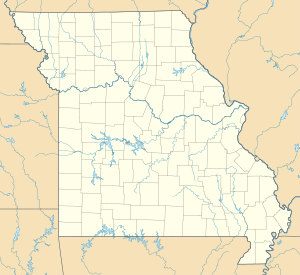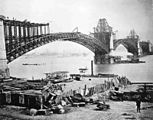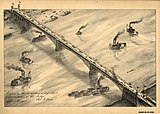Eads Bridge
Coordinates: 38 ° 37 ′ 41 ″ N , 90 ° 10 ′ 17 ″ W.
| Eads Bridge | ||
|---|---|---|
| use | two-story road and rail bridge | |
| Convicted | Eads Bridge Street, MetroLink | |
| Crossing of | Mississippi River | |
| place | St. Louis - East St. Louis | |
| Building number | NBI 12992 | |
| construction | Arch bridge | |
| overall length | 624 m | |
| width | 14 m | |
| Number of openings | three | |
| Longest span | 158 m | |
| Construction height | 27 m | |
| Clear height | 16.8 m | |
| vehicles per day | 8100 (2014), 168 trains | |
| start of building | 1867 | |
| opening | 1874 | |
| planner | James Buchanan Eads | |
| location | ||
|
|
||
The Eads Bridge is a combined rail and road bridge. It connects St. Louis in Missouri with East St. Louis in Illinois via the Mississippi River , which forms the border between the two states here. The MetroLink , a light rail system in the metropolitan region of St. Louis ( Greater St. Louis ), runs on the lower floor, and a four-lane street is located on the upper floor . When the bridge was completed in 1874, it had the largest spans of any arch bridge in the world.
history
The bridge is named after its designer and builder James Buchanan Eads , who had never planned or built a bridge before. The hydraulic engineer , who also had experience on the Mississippi as a diver, made a simple design of a bridge with three arches made of steel arch girders. Because of his knowledge of the river, he was convinced that the pillars could only be stable if their foundation reached down to the bedrock. His design led to his appointment as chief engineer of the newly formed St. Louis Bridge Company . There he developed the final plans with a staff of experienced bridge construction engineers. The construction of rib arches with spans of 158 m was considered daring at the time, as was the first-time use of steel as the most important component of the load-bearing parts. At that time it was considered the largest arch bridge in the world.
Construction began in August 1867 with the foundation work. For the construction of the abutments and pillars , Eads used the largest and, up until then, deepest caissons , a technique whose medical effects were virtually unknown at the time. They were also responsible for the first serious cases of decompression sickness . 15 workers died, two others became severely disabled and 77 were partially disabled.
Work on the superstructure began in April 1873. As falsework could be built because of shipping is not (and could probably not in size can be built) was the Eads Bridge one of the first modern bridges in cantilever with cantilevers were built. For this purpose, temporary wooden towers were erected on the abutments and pillars, over which wire ropes were passed, with which the parts of the arch protruding over the river were anchored.
On June 14, 1874, a " test elephant " was led over the bridge that had just been completed to test its safety. A large crowd cheered when a traveling circus first crossed the bridge on its way to Illinois. It was believed that elephants have an instinct for unsafe places. Two weeks later, Eads carried out a stress test on 14 locomotives that were simultaneously driving the bridge. The bridge was ceremoniously opened on July 4, 1874, the national holiday.
In January 1964, the bridge was granted National Historic Landmark status . Eads Bridge was listed on the NRHP in 1966 and was added to the List of National Historic Civil Engineering Landmarks by the American Society of Civil Engineers in 1971.
description
The Eads Bridge consists of three large segment arches with elevated railway tracks in the lower part and lanes for a four-lane road on the upper bridge deck. The arches each consist of four parallel arch girders ( rib arches ), the upper and lower chords of which are made of steel tubes and connected with wrought iron, truss-like struts. In a similar way, these four arches are stiffened by wrought iron struts.
The abutments and the bridge piers between the arches are made of limestone masonry clad with granite. On both sides of the abutments are brick viaducts, each with five round arches leading the tracks over the bank areas. Above the round arches there is a gallery of small arches that support the street deck. This is followed by long ramp bridges, with which the level of the surrounding area is reached.
The segment arches have spans of 158 m (520 ft) in the middle arch and 153 m (502 ft) in the two outer arches. The length of the actual bridge including the two bank viaducts is 624 m (2048 ft). The total length of the structure given as 1896 m (6220 ft) cannot be reproduced in today's road system.
The bridge has a clear height of 16.8 m (55 ft) above high water, and its deck is 16.5 m (54 ft) wide.
When building the bridge, the following were processed:
- 2,168 tons of steel
- 2,863 tons of wrought iron
- 731 tons of wooden planks
- 3,483 m 3 of concrete
- 74,598 m 3 of masonry
The railroad tracks are led within the western ramp bridge into a 1248 m long tunnel, which ends after a tight curve in South 8th Street at Stadium Station.
Current usage
Eads Bridge, which was the landmark of St. Louis until 1965 when the Gateway Arch was built, is still in operation today. The Eads Bridge takes you between downtown Laclade's Landing in the north and Gateway Arch in the south from Illinois to the city of St. Louis. Today the road leading over the bridge has two structurally separate lanes, each with two lanes, and one structurally separate path for pedestrians and cyclists in each direction. In 2014, 8,100 vehicles were counted per day (although two lanes were closed due to construction sites). The tracks on the lower level of the bridge have been used by the tram since 1993.
Art and media
The construction of the Eads Bridge forms the framework of volume 68 of the Lucky Luke comics, drawn by Morris .
literature
- Richard J. Cook: The Beauty of Railroad Bridges in North America - Then and Now. Published by Golden West Books, San Marino (California) 1987, ISBN 0-87095-097-5
- Howard S. Miller, Quinta Scott: The Eads Bridge. University of Missouri Press, Columbia (Missouri) & London 1979
Web links
- The Museum Gazette: James B. Eads and His Amazing Bridge at St. Louis . National Park Service (PDF; 212 kB)
- Eads Bridge . Private website of John A. Weeks III
- Eads Bridge on bridgehunter.com
- HABS / HAER: Eads Bridge, Spanning Mississippi River at Washington Street, Saint Louis, Independent City, MO on the Library of Congress website
- National Register of Historic Places Inventory - Nomination Form of the United States Department of the Interior - National Park Service (PDF; 9.3 MB)
Individual evidence
- ↑ Unless otherwise stated, the information in the following sections is based on the National Register of Historic Places Inventory - Nomination Form of the United States Department of the Interior - National Park Service (PDF; 9.3 MB)
- ↑ Eric DeLony, Context for World Heritage Bridges ( January 9, 2012 memento in the Internet Archive )
- ^ A b Butler WP Caisson disease during the construction of the Eads and Brooklyn Bridges: A review
- ^ The Museum Gazette: James B. Eads and His Amazing Bridge at St. Louis . National Park Service (PDF; 212 kB)
- ↑ St. Louis People 365 ( Memento of the original from July 18, 2011 in the Internet Archive ) Info: The archive link was automatically inserted and not yet checked. Please check the original and archive link according to the instructions and then remove this notice.
- ↑ Listing of National Historic Landmarks by State: Missouri. National Park Service , accessed August 16, 2019.
- ↑ Extract from the National Register of Historic Places - No. 66000946 Retrieved April 30, 2011
- ↑ Historic Civil Engineering Landmark Index, Eads Bridge ( Memento of the original from August 14, 2014 in the Internet Archive ) Info: The archive link was automatically inserted and has not yet been checked. Please check the original and archive link according to the instructions and then remove this notice.
- ↑ Information based on the lithograph The Bridge at St. Louis from 1874; other details vary slightly.
- ↑ IDOT: New bridge carrying less traffic than originally expected ( Memento of the original from July 14, 2014 in the Internet Archive ) Info: The archive link was inserted automatically and has not yet been checked. Please check the original and archive link according to the instructions and then remove this notice. on BND.com






